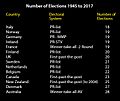Proportional representation facts for kids
Proportional representation is a way countries choose their leaders and lawmakers. It's designed to make sure that if a political party gets a certain percentage of votes, they get about the same percentage of seats in the government. This means if 30% of people vote for Party A, then Party A should get roughly 30% of the seats in the parliament or congress. It's all about fairness and making sure everyone's vote counts.
Contents
What is Proportional Representation?
Imagine a big classroom where students vote for their class representatives. If 10 students vote for Group A, 5 for Group B, and 5 for Group C, proportional representation would try to give Group A twice as many representatives as Group B or C.
In a country, this means if a political party wins 40% of all the votes, they should get close to 40% of the seats in the national assembly. This system aims to reflect the different opinions of the voters as accurately as possible in the government. It helps make sure that smaller parties, or parties with support spread across the country, can still win seats.
How Does it Work?
There are different ways to make proportional representation happen, but the main idea is always the same: votes equal seats. One common method is called the "party-list system." In this system, voters usually choose a political party, not just one person. Each party creates a list of candidates. If a party wins enough votes, the candidates from the top of their list get the seats.
Another way is the "mixed-member proportional" system. Here, people might vote for a local representative and also for a party. The party votes are then used to make sure the overall number of seats matches the total votes for each party.
Why Use This System?
Many countries use proportional representation because they believe it's the fairest way to elect a government. It helps ensure that almost every vote contributes to electing someone. This can lead to governments that include several parties working together, which means more voices are heard in decision-making. It also encourages different groups of people to participate in elections, knowing their votes can make a difference.
Countries Using Proportional Representation
Many countries around the world use proportional representation to elect their governments. These systems help ensure that the government truly reflects the different views of its people.
Some countries that use this system include:
- Austria
- Argentina
- Belgium
- Brazil
- Bulgaria
- Czech Republic
- Denmark
- Estonia
- Finland
- Greece
- Iceland
- Ireland
- Israel
- Netherlands
- Norway
- Poland
- Portugal
- Romania
- Russia
- South Africa
- South Korea
- Spain
- Sri Lanka
- Sweden
- Switzerland
- Turkey
Countries with Similar Systems
Some countries use systems that are a bit like proportional representation, or they mix it with other election methods. These are sometimes called semi-proportional systems. They try to get some of the fairness of proportional representation while also keeping other features.
Countries with similar or semi-proportional systems include:
- Australia
- Germany
- Hungary
- India
- Republic of Ireland
- Italy
- Japan
- Mexico
- New Zealand
- Scotland
- Thailand
- Wales
India is a very large country that uses a system with proportional elements, and it is often seen as a successful example of how such a system can work in a big and diverse nation.
Images for kids
See also
In Spanish: Escrutinio proporcional plurinominal para niños


